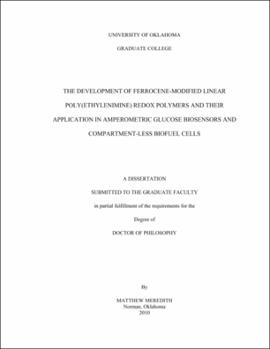| dc.contributor.advisor | Glatzhofer, Daniel T | |
| dc.creator | Meredith, Matthew Thomas | |
| dc.date.accessioned | 2019-04-27T21:30:33Z | |
| dc.date.available | 2019-04-27T21:30:33Z | |
| dc.date.issued | 2010 | |
| dc.identifier | 99253076502042 | |
| dc.identifier.uri | https://hdl.handle.net/11244/318857 | |
| dc.description.abstract | A series of redox polymers was synthesized by attaching various ferrocene derivatives to linear poly(ethylenimine) (LPEI). These polymers displayed a remarkable ability to shuttle electrons from the active site of the enzyme glucose oxidase (GOx) to the surface of an electrode. | |
| dc.description.abstract | The first type of polymer which was studied consisted of LPEI modified with a ferrocenylmethyl group (Fc-C1-LPEI). A new, versatile method was developed for the synthesis of this polymer at any substitution percentage (between 1% and 100%). The electrochemistry of these polymers in solution was unique and they displayed a double-wave behavior under acidic conditions which could be used to estimate the degree of protonation on the polymer backbone. As biosensors, it was found that polymers with 20% substitution performed the best, but that between 10% and 25%, the performance did not vary much. | |
| dc.description.abstract | Because the polymer designated as Fc-C1-LPEI was believed to be unstable under physiological conditions due to its proximity to the LPEI backbone, polymers with different spacer lengths between the ferrocene and the polymer backbone were synthesized (Fc-C6-LPEI and Fc-C3-LPEI). Increasing the distance between the ferrocene and the backbone was shown to increase the lifetime of biosensors made with Fc-C6-LPEI and Fc-C3-LPEI 10-fold over that of Fc-C1-LPEI. Sensors made with Fc-C6-LPEI had lower maximum current densities than those made with Fc-C3-LPEI, and it was determined that three carbons was the optimal spacer length for these redox polymers. | |
| dc.description.abstract | Once the optimal spacer length was determined, a new polymer, FcMe2-C3-LPEI was synthesized using dimethylferrocene instead of ferrocene. It was shown that the added methyl groups on the ferrocene resulted in biosensors with increased electrochemical and operational stability. This polymer (along with Fc-C3-LPEI) was shown to produce current densities of ~ 2 mA/cm2 at 37o C, which made it an attractive candidate for use in a biofuel cell. Biofuel cells using Fc-C3-LPEI and FcMe2-C3-LPEI as anodic mediators were constructed and produced power densities of up to 56 µW/cm2 in a stationary mode and 146 µW/cm2 when a rotating biocathode was used. FcMe2-C3-LPEI was shown to be a superior bioanode material for biofuel cells due to its lower redox potential and higher stability. | |
| dc.description.abstract | In order to increase the biofuel cell power density further (as well as make a more effective glucose biosensor), tetramethylferrocene-modified LPEI (FcMe4-C3-LPEI) was synthesized in order to create a redox polymer with more stability and a lower redox potential. The desired effect of lowering the redox potential was achieved, and stationary biofuel cells using FcMe4-C3-LPEI produced power densities of up to 70 µW/cm2. However, when a rotating cathode was used, the performance of biofuel cells using FcMe4-C3-LPEI was not significantly better than that of biofuel cells using FcMe2-C3-LPEI. This was due to the lower limiting current densities produced by the FcMe4-C3-LPEI bioanodes. | |
| dc.format.extent | 269 pages | |
| dc.format.medium | application.pdf | |
| dc.language | en_US | |
| dc.relation.requires | Adobe Acrobat Reader | |
| dc.subject | Biosensors | |
| dc.subject | Polymers in medicine | |
| dc.subject | Ferrocene | |
| dc.title | THE DEVELOPMENT OF FERROCENE-MODIFIED LINEAR POLY(ETHYLENIMINE) REDOX POLYMERS AND THEIR APPLICATION IN AMPEROMETRIC GLUCOSE BIOSENSORS AND COMPARTMENT-LESS BIOFUEL CELLS | |
| dc.type | text | |
| dc.type | document | |
| dc.thesis.degree | Ph.D. | |
| ou.group | College of Arts and Sciences::Department of Chemistry and Biochemistry | |
